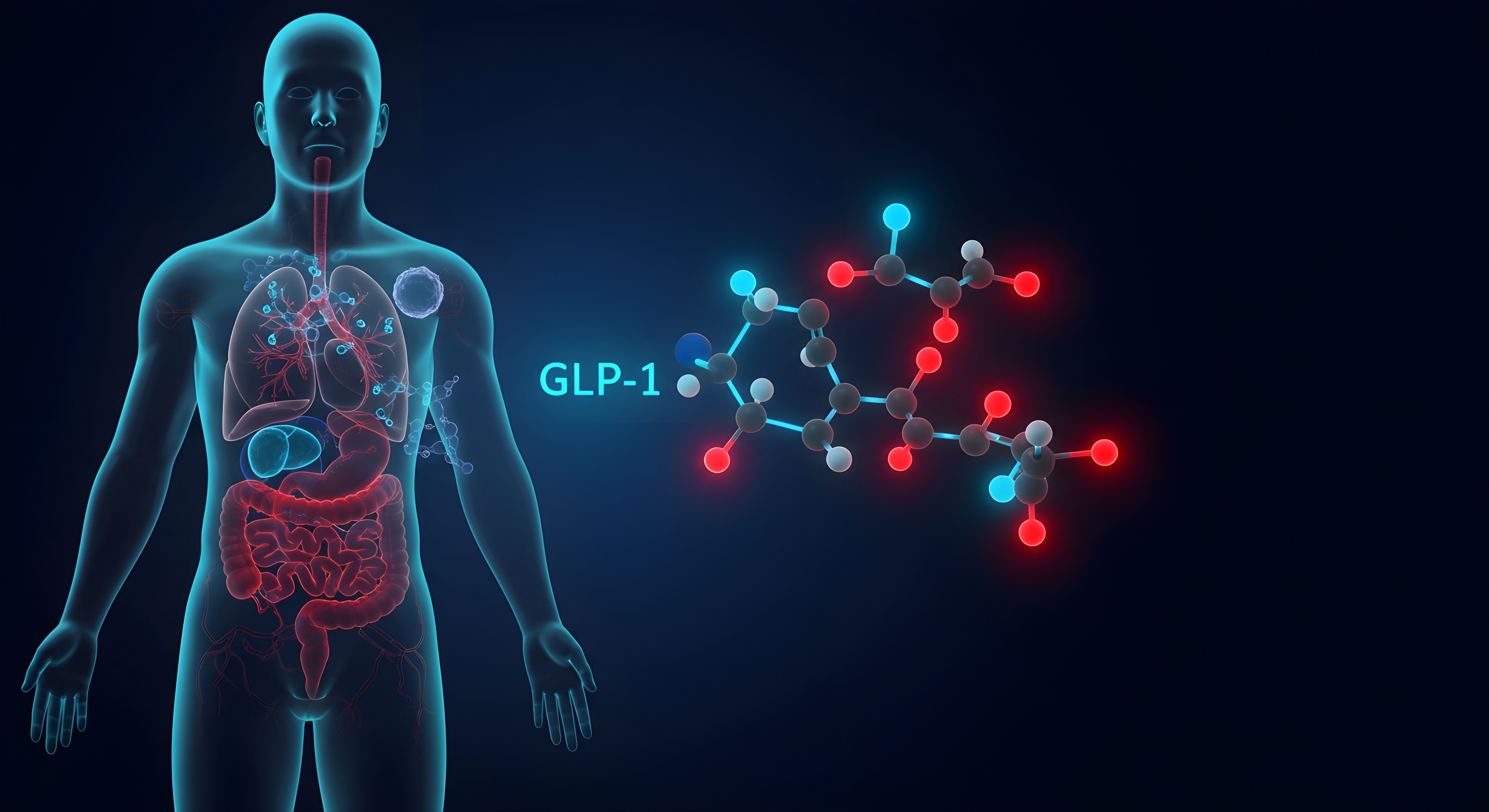Publication
Article
Psychiatric Times
Antidepressants in Pregnancy: Balancing Needs and Risks in Clinical Practice
Author(s):
This article summarizes the risks of untreated psychiatric illness during pregnancy as well as the risks and benefits of antidepressant use.
SIGNIFICANCE FOR THE PRACTICING PSYCHIATRIST
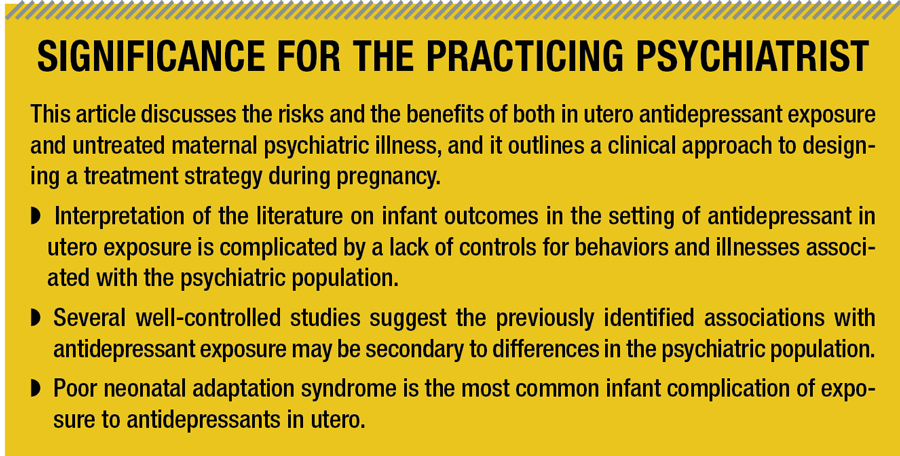
Risks of untreated psychiatric illness during pregnancy
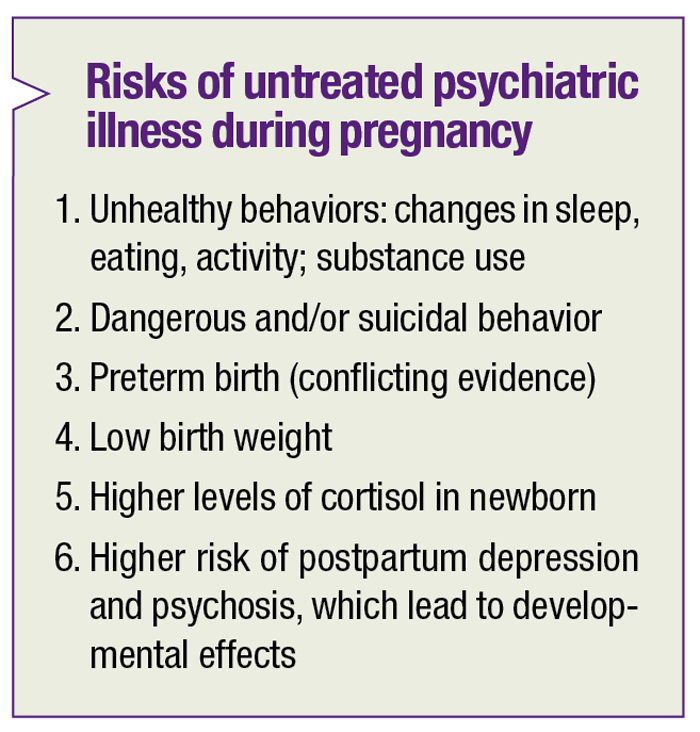
Tips for reading the psychiatric literature on in utero antidepressant exposure and infant outcomes

TABLE. Studies of infant outcomes adjusted for psychiatric illness and severity of illness
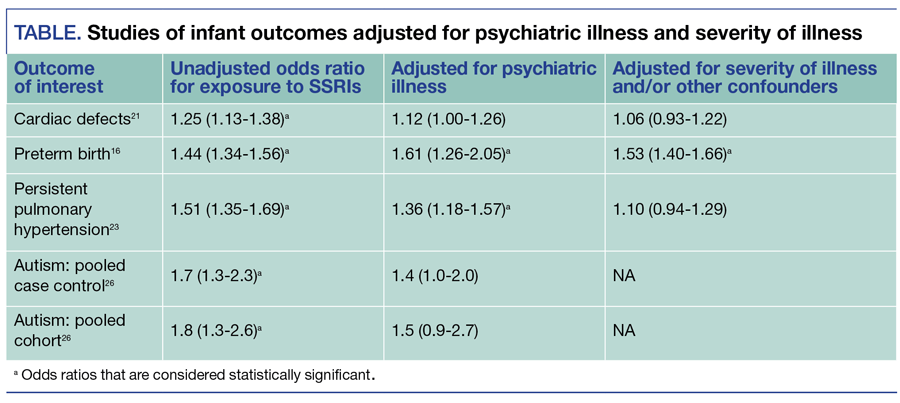
Practical advice for designing a psychiatric medication plan for pregnancy
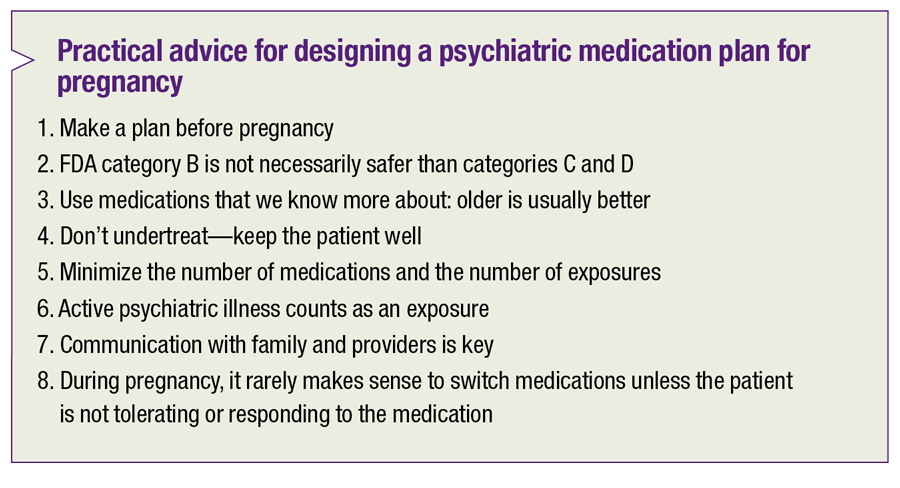
The controversy surrounding the use of antidepressants during pregnancy is well publicized, widespread, and confusing-which leaves many general psychiatrists unsure about how best to care for pregnant patients. This article will summarize the risks of untreated psychiatric illness during pregnancy as well as the risks and benefits of antidepressant use. The goal is to provide practical guidelines to help clinicians and their patients make informed treatment decisions for pregnancy.
Risks of in utero exposure to maternal depression and anxiety
About 15% of all pregnant women have a psychiatric illness.1 The risk of MDD during pregnancy is roughly comparable to the risk during other times in a woman’s life. However, in women with preexisting MDD, the risk of relapse during pregnancy increases when medication is discontinued. The relapse rate is as high as 68% when drug therapy is stopped during the first trimester.2 Anxiety disorders are also extremely common during pregnancy: up to 27% of women are affected.3
Beyond the obvious risks of suicide and unhealthy behaviors associated with untreated MDD and anxiety (including higher BMI, decreased compliance with prenatal care, higher rates of substance use, poorer nutrition, and decreased rates of breastfeeding), studies indicate that untreated psychiatric illness is directly correlated with adverse neonatal and child outcomes.4 Untreated MDD has been associated with significantly increased risks of preterm birth and low birth weight.5 Other studies have demonstrated elevated cortisol levels in infants exposed to maternal MDD and increased rates of child behavioral and emotional problems.6 Untreated antepartum depression is also one of the strongest risk factors for postpartum depression,7 which is associated with impaired maternal-infant bonding8; impaired parenting behavior9; and adverse child outcomes, including lower IQ, slower language development, and behavioral disturbance10; as well as potentially devastating consequences such as suicide and infanticide. Clearly, the decision not to treat a woman during pregnancy should be made with great caution.
Interpreting the literature about in utero antidepressant exposure
The literature on the safety of in utero antidepressant exposure is large, robust, and often contradictory. Because many studies are small, retrospective, and observational, it is not uncommon for studies of the same risks and outcomes to have findings that directly contradict one another (for a good example, see the discussion of persistent pulmonary hypertension [PPHN] below). In fact, antidepressants are one of the best-studied classes of medications in pregnancy. To make sense of this vast literature, it is important to bear in mind its substantial limitations, including:
1)Confounding by indication. Unfortunately, many studies are marred by poor control of confounding factors associated with depressive and anxiety disorders. For example, women with MDD differ from the general population of women in several important ways, including health-related behaviors; associated illnesses such as diabetes; and rates of obesity, smoking, and substance use. Studies that have not controlled for these factors may find associations between in utero antidepressant exposure and outcomes that may not be causally linked to exposure to the medication itself, but rather to exposure to these confounding characteristics. The Table presents results from 4 studies of infant outcomes that have attempted to control for confounding by indication and severity of illness. It demonstrates how results may or may not change with controlling for confounding factors.
2)Confounding by active illness. Changes in maternal behavior as well as serum cortisol and neurotransmitter levels associated with active depressive symptoms may have direct effects on infant physiology and development that may be hard to distinguish from the effects of exposure to antidepressants. For example, a recent meta-analysis found an association between antenatal depression and both preterm birth and low birth weight, with a stronger effect for more severe depressive symptoms.11 Few published studies in this area control for active symptomatology. To further complicate the picture, many women who take antidepressants during pregnancy are undertreated and may still experience significant depressive symptoms, thus exposing the infant to both medication and psychiatric illness.12
3)Statistical meaningfulness. Many headlines in both the popular press and scientific journals emphasize positive associations with in utero antidepressant exposure without telling the whole story. For example, the popular press (including the Washington Post13 and the Huffington Post14) recently trumpeted an “87% increased risk of autism” based on a press release by an author’s university about the findings of one study-but the coverage did not reflect that the study found an absolute risk increase from 0.7% to 1.3% and was based on 31 infants.15 Nor was it widely reported that the finding became nonsignificant when rigorous clinical diagnoses of autism were applied. Similarly, many studies find a statistically significant effect of antidepressant exposure on the likelihood of preterm birth-but fail to emphasize that the absolute reduction in gestational age is 3 to 4 days, which is of questionable clinical significance.16,17
Risks studied for in utero antidepressant exposure
Preterm birth. Although findings are conflicting, untreated depression has been associated with preterm birth; thus, it is important to control for depression in antidepressant exposure studies. Several well-designed trials and meta-analyses have found a risk of preterm birth with antidepressant exposure,16,17 independent of the risk of a diagnosis of depression (see Table). To date, the data indicate that antidepressant use in pregnancy may be associated with an increased risk of preterm birth; however, the clinical significance of this association remains unclear. The risk, if real, may be for both untreated illness and antidepressant exposure-and therefore of little use in making treatment decisions.
Cardiac defects and persistent pulmonary hypertension. Studies that examined the association between in utero antidepressant exposure and infant cardiac defects exemplify the importance of controlling for confounding factors. Cardiac defects are the most common congenital abnormalities, and early studies seemed to find associations between SSRI use and cardiac defects, especially ventricular septal defects and ventricular outflow tract obstructions.18-20 Most of these early studies, however, compared psychiatric population outcomes with general population outcomes.
More recent, well-controlled studies have not found an association between antidepressant exposure and heart defects when outcomes are compared in 2 psychiatric populations. Huybrechts and colleagues21 controlled for psychiatric illness comorbidities in a sample of over 900,000 by comparing the outcomes of women with MDD who took antidepressants with those of women with MDD who did not take antidepressants, taking into account both known and unknown differences between these 2 populations (see Table). They found no association. Similarly, a meta-analysis of prospective cohort studies found no association between SSRI use in the first trimester and heart defects when women with MDD who took antidepressants during pregnancy were compared with those who did not.22 Thus, the previously identified association between in utero antidepressant exposure and heart defects appears to be associated with other risk factors.
A similar story has evolved for the possible association between in utero antidepressant exposure and PPHN in the newborn. PPHN occurs when the high pulmonary vascular resistance necessary for fetal circulation in utero fails to diminish appropriately at birth; the result is a right-to-left shunt and decreased neonatal blood flow through the lungs, leading to respiratory failure. Studies to date have been conflicting, but the most recent analyzed close to 3.8 million pregnancies and found no association between SSRIs and PPHN when the analyses were adjusted for potential confounding factors associated with MDD (see Table).23 There was, however, a significant association when the cases were limited to primary PPHN and term deliveries (odds ratio, 1.28; confidence interval, 1.01-1.64). Notably, a previous study found that PPHN in the newborn was associated with a history of psychiatric hospitalization even when the mother abstained from antidepressant use during pregnancy,24 which indicates that other factors associated with MDD may increase the risk of PPHN rather than in utero antidepressant exposure. The absolute risk remains less than 1%, even if the risk results from SSRI exposure.
Autism. The most recent series of studies examined whether there is an association between in utero antidepressant exposure and autism based on the “serotonin hypothesis of autism,” which posits that fetal exposure to high levels of serotonin in utero leads to the autism phenotype.25 The data are conflicting and plagued by limitations. A recent systematic review and meta-analysis found that controlling for maternal mental illness in a meta-analysis of 4 case-control studies eliminated statistically significant findings except for first-trimester exposure and completely attenuated the relationship in 2 pooled cohort studies (see Table).26 The authors concluded that further study is required to rule out a positive association with first-trimester exposure and/or residual confounding.
Poor neonatal adaptation syndrome. One infant outcome that is clearly associated with in utero antidepressant exposure is poor neonatal adaptation syndrome (PNAS). Symptoms can include respiratory distress, cyanosis, apnea, seizures, temperature instability, feeding difficulty, vomiting, hypoglycemia, hypotonia, hypertonia, hyperreflexia, tremor, jitteriness, irritability and, rarely, seizures. Most cases appear to be mild, self-limited, and without lasting repercussions, although recent data suggest that motor and CNS effects may still be identified at 1 month postpartum, and longer-term studies need to be completed.27 Approximately one-third of exposed infants have at least mild symptoms consistent with the syndrome, and this risk increases when multiple agents, particularly benzodiazepines, are used.28
A practical approach to antidepressant use in pregnancy
How do we integrate all the information about the risks of both treatment and lack of treatment into a practical clinical approach? The ideal situation is to begin planning for pregnancy before conception. The patient’s psychiatric history, severity of illness, past medication response, and wishes for treatment during pregnancy should be taken into account. Every case should be considered individually. Ultimately, there is no set approach: just the weighing of risks and benefits of the various options for the individual patient.
The primary goal of treatment in pregnancy is to minimize the number of exposures. This means not only minimizing the number of medications but also limiting exposure to psychiatric illness.
When determining which antidepressant to use during pregnancy, remember that in general we have more information about older antidepressants than newer ones. This fact is reflected in the old FDA pregnancy categories. Categories include A, B, C, D, and X, and the hierarchy is based on the amount of evidence for safety in animal and human studies, not on the level of risk. Medications in category B simply have not been studied adequately in humans to warrant placing them in category A as safe (or in C, D, or X), and most medications new to the market will therefore be in category B. Prescribers may make the mistake of prescribing a category B medication over an older medication in category C or D, thinking it is safer, when in fact less is known about its safety during pregnancy. While these categories are being phased out, they will still apply to drugs approved before 2001 for some time.
Should women switch to better-studied medications before pregnancy? If decisions are being made well in advance, and the woman does not have a history of non-response to the better-studied medication, she can attempt a switch. Switching to another antidepressant during pregnancy rarely makes sense (unless the woman is not responding), since the baby has already been exposed and switching would increase the number of exposures to medications and potentially depressive illness.
What if the patient is already pregnant? The same principles apply, with an important addition: don’t stop all psychiatric medications immediately. Stopping precipitously can cause great distress, precipitate withdrawal, and induce a relapse of mental illness. The best approach is to review the medication list based on the principles outlined above. Keep in mind that the baby has already been exposed, and while stopping some medications may make sense to minimize the impact on the child, doing so in a controlled and logical fashion is ideal.
Despite increasing evidence of safety, many patients decide not to take psychiatric medications during pregnancy. Many feel guilty about taking any medication during pregnancy, and most women overestimate the risks of medication and underestimate the risks of untreated mood disorders during pregnancy. In this situation, it is appropriate to offer close follow-up care so that relapses are identified early and treatment can be offered. Evidence-based nonpharmacological treatments, including psychotherapy, yoga, and acupuncture, should be incorporated whenever possible (whether the patient is receiving medication or not!).
It is also important to keep in mind that the patient and her family must feel comfortable with the treatment used during pregnancy, so they do not look back and regret decisions made during this critical period. Educating the family about the risks and benefits of treatment, the risks of untreated psychiatric illness to both mother and child, as well as signs and symptoms of relapse, is essential to providing good clinical care.
Conclusion
Interpretation of the literature on in utero antidepressant exposure is complicated by confounding variables associated with psychiatric illness. Current evidence is generally reassuring and indicates that the absolute risks of negative infant outcomes are small except for PNAS, which largely appears to be self-limited. In contrast, the risks associated with exposure to significant maternal depression are substantial. A plan to minimize the number of exposures both to medication and to illness, along with close psychiatric follow-up and communication with all involved parties, serves to maximize outcomes for both mothers and their children.
Disclosures:
Dr. Osborne is Assistant Director, Women’s Mood Disorders Center, Johns Hopkins School of Medicine, Baltimore, MD, and Assistant Professor of Psychiatry and Behavioral Sciences, Johns Hopkins School of Medicine. Dr. McEvoy is a Postdoctoral Fellow in Women’s Mental Health in the Department of Psychiatry, Johns Hopkins School of Medicine. Dr. Payne is Director, Women’s Mood Disorders Center, Johns Hopkins School of Medicine, and Associate Professor of Psychiatry and Behavioral Sciences, Johns Hopkins School of Medicine.
Dr. Osborne reports no conflicts of interest concerning the subject matter of this article. Dr. Payne receives research support from and is a consultant for Sage Therapeutics; she has provided expert testimony for Eli Lilly, Astra Zeneca, Johnson and Johnson, and Abbott Pharmaceuticals.
References:
1. Andersson L, Sundstrom-Poromaa I, Bixo M, et al. Point prevalence of psychiatric disorders during the second trimester of pregnancy: a population-based study. Am J Obstet Gynecol. 2003;189:148-154.
2. Cohen LS, Altshuler LL, Harlow BL, et al. Relapse of major depression during pregnancy in women who maintain or discontinue antidepressant treatment. JAMA. 2006;295:499-507.
3. Brunton RJ, Dryer R, Saliba A, Kohlhoff J. Pregnancy anxiety: a systematic review of current scales. J Affect Disord . 2015;176:24-34.
4. Kim HG, Mandell M, Crandall C, et al. Antenatal psychiatric illness and adequacy of prenatal care in an ethnically diverse inner-city obstetric population. Arch Womens Ment Health. 2006;9:103-107.
5. Grigoriadis S, VonderPorten EH, Mamisashvili L, et al. The effect of prenatal antidepressant exposure on neonatal adaptation: a systematic review and meta-analysis. J Clin Psychiatry. 2013;74:e309-e320.
6. Field T. Prenatal depression effects on early development: a review. Infant Behav Dev . 2011;34:1-14.
7 . Robertson E, Grace S, Wallington T, Stewart DE. Antenatal risk factors for postpartum depression: a synthesis of recent literature. Gen Hosp Psychiatry. 2004; 26:289-295.
8. Akman I, Kuscu K, Ozdemir N, et al. Mothers’ postpartum psychological adjustment and infantile colic. Arch Dis Child . 2006;91:417-419.
9. McLearn KT, Minkovitz CS, Strobino DM, et al. The timing of maternal depressive symptoms and mothers’ parenting practices with young children: implications for pediatric practice. Pediatrics. 2006;118:e174-e182.
10. Grace SL, Evindar A, Stewart DE. The effect of postpartum depression on child cognitive development and behavior: a review and critical analysis of the literature. Arch Womens Ment Health. 2003;6:263-274.
11. Jarde A, Morais M, Kingston D, et al. Neonatal outcomes in women with untreated antenatal depression compared with women without depression: a systematic review and meta-analysis. JAMA Psychiatry. 2016;73:826-837.
12. Kimmel M, Hess E, Roy PS, et al. Family history, not lack of medication use, is associated with the development of postpartum depression in a high-risk sample. Arch Womens Ment Health. 2015;18:113-121.
13. Cha AE. Maternal exposure to anti-depressant SSRIs linked to autism in children. Washington Post. December 17, 2015.
14. Almendrala A. Major study links autism to antidepressant use during pregnancy. Huffington Post. December 15, 2015.
15. Boukhris T, Sheehy O, Mottron L, Berard A. Antidepressant use during pregnancy and the risk of autism spectrum disorder in children. JAMA Pediatrics. 2016;170:117-124.
16. Huybrechts KF, Sanghani RS, Avorn J, Urato AC. Preterm birth and antidepressant medication use during pregnancy: a systematic review and meta-analysis. PloS One. 2014;9:e92778.
17. Sit D, Perel JM, Wisniewski SR, et al. Mother-infant antidepressant concentrations, maternal depression, and perinatal events. J Clin Psychiatry. 2011;72:994-1001.
18. Louik C, Lin AE, Werler MM, et al. First-trimester use of selective serotonin-reuptake inhibitors and the risk of birth defects. N Engl J Med. 2007;356:2675-2683.
19. Alwan S, Reefhuis J, Rasmussen SA, et al. Use of selective serotonin-reuptake inhibitors in pregnancy and the risk of birth defects. N Engl J Med. 2007; 356:2684-2692.
20. Pedersen LH, Henriksen TB, Vestergaard M, et al. Selective serotonin reuptake inhibitors in pregnancy and congenital malformations: population based cohort study. BMJ. 2009;339:b3569.
21. Huybrechts KF, Palmsten K, Avorn J, et al. Antidepressant use in pregnancy and the risk of cardiac defects. N Engl J Med. 2014;370:2397-2407.
22. Wang S, Yang L, Wang L, et al. Selective serotonin reuptake inhibitors (SSRIs) and the risk of congenital heart defects: a meta-analysis of prospective cohort studies. J Am Heart Assoc. 2015;4:e001681.
23. Huybrechts KF, Bateman BT, Palmsten K, et al. Antidepressant use late in pregnancy and risk of persistent pulmonary hypertension of the newborn. JAMA. 2015;313:2142-2151.
24. Kieler H, Artama M, Engeland A, et al. Selective serotonin reuptake inhibitors during pregnancy and risk of persistent pulmonary hypertension in the newborn: population based cohort study from the five Nordic countries. BMJ. 2012;344:d8012.
25. Harrington RA, Lee LC, Crum RM, et al. Serotonin hypothesis of autism: implications for selective serotonin reuptake inhibitor use during pregnancy. Autism Res. 2013;6:149-168.
26. Brown HK, Hussain-Shamsy N, Lunsky Y, et al. The association between antenatal exposure to selective serotonin reuptake inhibitors and autism: a systematic review and meta-analysis. J Clin Psychiatry. 2017;78:e48-e58.
27. Salisbury AL, O’Grady KE, Battle CL, et al. The roles of maternal depression, serotonin reuptake inhibitor treatment, and concomitant benzodiazepine use on infant neurobehavioral functioning over the first postnatal month. Am J Psychiatry. 2016;173:147-157.
28. Oberlander TF, Misri S, Fitzgerald CE, et al. Pharmacologic factors associated with transient neonatal symptoms following prenatal psychotropic medication exposure. J Clin Psychiatry. 2004;65:230-237.
Newsletter
Receive trusted psychiatric news, expert analysis, and clinical insights — subscribe today to support your practice and your patients.






